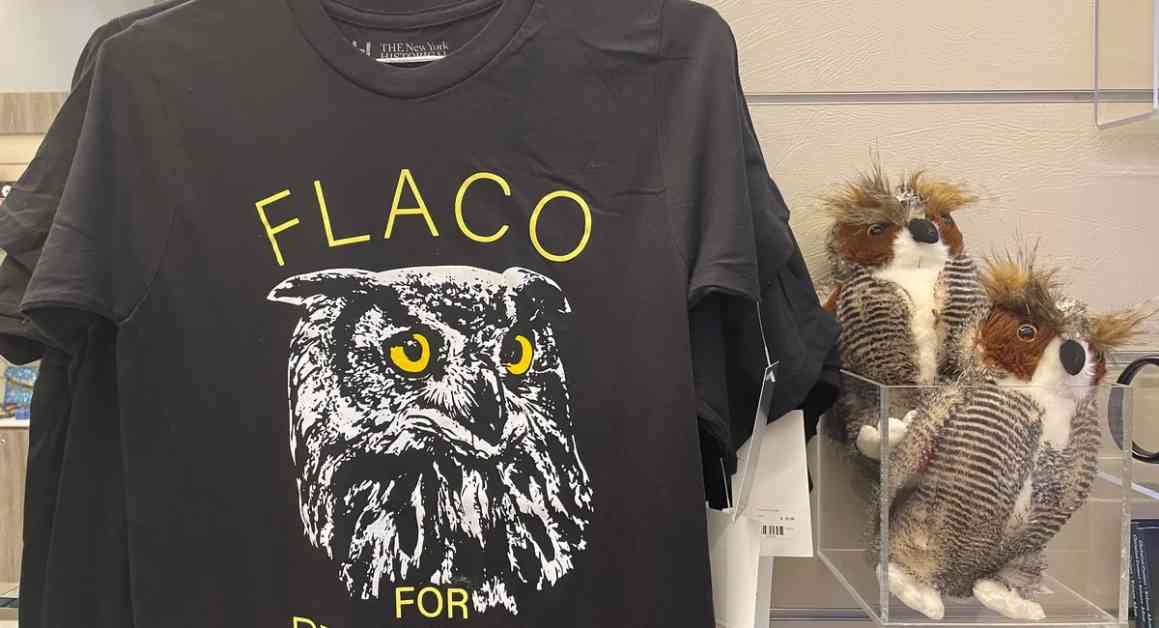One year ago, New York City lost its beloved Eurasian eagle-owl, Flaco, in a tragic accident when he flew into a building. However, his legacy lives on through a captivating exhibit at the New York Historical Society. The exhibit showcases around 100 items that narrate the story of Flaco’s remarkable life as a free-spirited bird who found solace in the bustling metropolis of New York City.
Flaco’s journey was nothing short of extraordinary. Born in captivity, like his parents, he lacked the knowledge of flying and hunting. When an opportunity for freedom presented itself after his enclosure was vandalized, Flaco seized the chance and escaped from the Central Park Zoo. This bold move marked the beginning of his adventure in the wilds of Manhattan, where he roamed the city streets, parks, and neighborhoods, learning to soar and hunt for survival.
The “Year of Flaco” exhibition at the New York Historical Society is a poignant tribute to this majestic creature. The showcase features over 30 photographs that capture Flaco’s various escapades, from perching on Upper West Side fire escapes to resting on park benches. Visitors to the exhibit, like Catherine Gleason, were deeply moved by Flaco’s story, finding a sense of hope in the owl’s ability to thrive in the urban jungle.
Flaco’s ability to adapt to city life and fend for himself resonated with many New Yorkers, turning him into a symbol of resilience and tenacity. Despite his tragic demise, Flaco’s memory lives on through the outpouring of love and support from the community. The exhibit not only honors his life but also raises awareness about the perils faced by wildlife in urban environments.
Flaco’s Impact on New Yorkers
Flaco’s unexpected journey from captive bird to free-spirited wanderer captivated the hearts of New Yorkers, who saw in him a reflection of their own struggles and triumphs. His story symbolized the spirit of the city, where even the most unlikely individuals can find their place and make a mark.
Carol Weiss, an Upper West Side resident, shared her sentiments about Flaco, highlighting the excitement and pride that New Yorkers felt in witnessing the owl navigate the concrete jungle. She remarked, “It was an exciting New York thing to follow this wonderful bird living in our city because if you can make it here, you can make it anywhere.”
Flaco’s Enduring Legacy
Flaco’s untimely death left a void in the hearts of many New Yorkers, but his memory continues to inspire meaningful actions. A petition calling for a statue of Flaco in Central Park has garnered thousands of signatures, a testament to the profound impact he had on the community. Additionally, his wings are preserved at the American Museum of Natural History, serving as a reminder of his majestic presence.
Furthermore, Flaco’s tragic fate has spurred initiatives to protect wildlife in the city. A New York City Council bill advocating for the use of rat contraceptives instead of poison has been introduced, aiming to prevent similar incidents in the future. Flaco’s legacy transcends his physical existence, serving as a catalyst for positive change in urban wildlife conservation.
As visitors walk through the exhibit at the New York Historical Society, they are greeted by a collection of handwritten letters, drawings, and memorabilia that pay homage to Flaco’s adventurous spirit. His impact on the city and its residents is evident in the outpouring of love and admiration displayed in these heartfelt tributes.
In conclusion, Flaco may have been a mere bird to some, but to many New Yorkers, he was a symbol of resilience, freedom, and the enduring spirit of the city. His legacy lives on, not just in the artifacts and memories preserved in the exhibit, but in the hearts of those who were touched by his remarkable story. As Mariana Hernandez, a Queens resident, aptly put it, “Flaco was very loved.”












